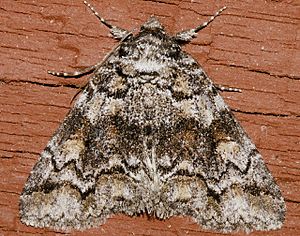Pine false looper zale facts for kids
Quick facts for kids Pine false looper zale |
|
|---|---|
 |
|
| Scientific classification | |
| Kingdom: | |
| Phylum: | |
| Class: | |
| Order: | |
| Family: | |
| Genus: |
Zale
|
| Species: |
Z. duplicata
|
| Binomial name | |
| Zale duplicata (Bethune, 1865)
|
|
| Synonyms | |
|
|
The Pine False Looper Zale (scientific name: Zale duplicata) is a type of moth that belongs to the Noctuidae family. It's also known by other names like the pine false looper, banded similar-wing, or grey similar-wing. This moth was first officially described by a scientist named Charles J. S. Bethune in 1865.
Contents
About the Pine False Looper Zale
You can find this moth living in woodlands and forests across a wide area. It stretches from British Columbia in Canada all the way to Nova Scotia, and then south into the mountains of Georgia and Texas in the United States.
What it Looks Like
Adult Pine False Looper Zale moths have a wingspan of about 34 to 36 mm. That's roughly the length of a standard paperclip! In places like Alberta, Canada, you can usually see the adult moths flying around from late May to June.
Life Cycle
These moths have one generation each year. This means that from egg to adult, their full life cycle happens once within a year.
Larvae and Their Food
The young moths, called larvae or caterpillars, mostly eat the needles of eastern white pine trees. You can find them on these trees from New Brunswick to North Carolina. In areas further north and west, they also eat other types of pine trees. These include both "hard pines" (which have two or three needles in a bundle) and "soft pines" (which usually have five needles in a bundle).
One special type of this moth, called Zale duplicata largera, only eats the needles of jack pine trees.
Subspecies
Scientists have identified two main types, or subspecies, of the Pine False Looper Zale:
- Zale duplicata duplicata
- Zale duplicata largera (J. B. Smith, 1908)

